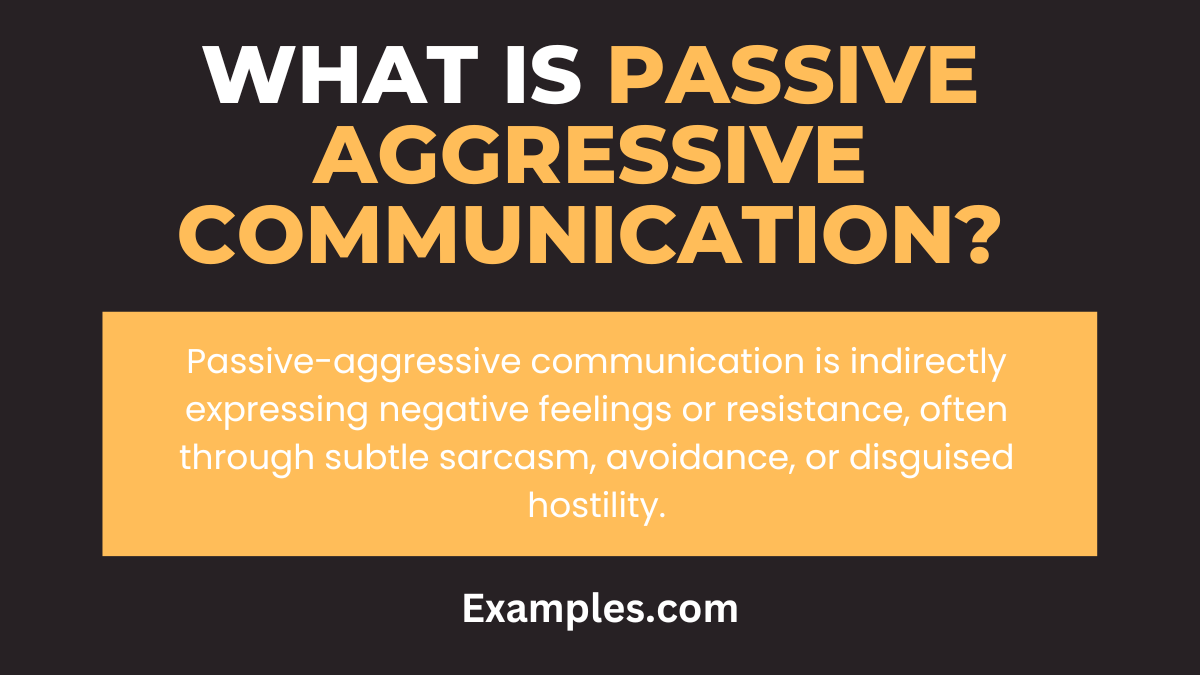What is Passive Aggressive Communication?
Passive Aggressive Communication is a nuanced and often misunderstood form of non-verbal communication. It involves expressing negative feelings, resentment, or aggression in an indirect and subtle manner. This guide offers a deep dive into its definition and meaning, providing practical examples and tips on how to recognize and use this form of communication effectively. Understanding ‘Non Verbal Communication’ in this context is key to decoding the subtle cues of passive aggression and navigating complex interpersonal dynamics.
What is Passive Aggressive Communication? – Definition

Passive Aggressive Communication is a way of expressing negative feelings, resentment, or anger in an indirect way instead of directly talking about them. It’s like showing you are upset or annoyed not through words, but through actions or non-verbal cues. For example, someone might agree to do something but then do it late or poorly, or they might use sarcasm to hide their real feelings. This type of communication often happens when someone doesn’t feel comfortable being open about their emotions, so they express them in a hidden, sometimes confusing way. It can lead to misunderstandings and problems in relationships because the true feelings and issues are not clearly addressed.
Passive Aggressive Communication Examples
The Examples of Passive Aggressive Communication are:
- Sarcasm: Using sarcasm to express displeasure instead of directly stating it.
- Silent Treatment: Deliberately ignoring someone as a form of punishment.
- Backhanded Compliments: Giving compliments that contain a subtle insult.
- Procrastination: Intentionally delaying tasks as a form of resistance.
- Subtle Insults: Making indirect remarks to express hostility.
- Facial Expressions: Rolling eyes or smirking to convey contempt.
- Withholding Information: Intentionally not sharing necessary information.
- Sighing or Eye Rolling: Expressing annoyance non-verbally.
- Feigned Helplessness: Pretending to be incapable to avoid responsibility.
- Ambiguous Speech: Being deliberately vague or misleading.
Characteristics of Passive Aggressive Communication
Characteristics of Passive Aggressive Communication are marked by indirect expression of hostility, such as sarcasm, silent treatment, subtle insults, and deliberate procrastination. It’s a covert way of expressing resentment without direct confrontation.
Advantages and Disadvantages of Passive Aggressive Communication
Advantages and Disadvantages of Passive Aggressive Communication include avoiding direct conflict and expressing displeasure without open hostility and miscommunication, unresolved conflicts, and potential relationship strain due to indirect and unclear messages.
How to Respond to Passive Aggressive Communication?
How to Respond to Passive Aggressive Communication:
Respond by staying calm, addressing the behavior directly, encouraging open communication, and setting clear boundaries. It’s important to avoid responding with aggression and instead seek constructive dialogue.
Signs of a Passive Aggressive Person
Signs of a Passive Aggressive Person often express negativity indirectly, use sarcasm, give backhanded compliments, show inconsistency between their words and actions, and might procrastinate on tasks to express resentment.
Passive Aggressive Communication Examples in a Business
Passive Aggressive Communication Examples in a Business include consistently missing deadlines as a form of silent protest, giving non-committal responses to important emails, or using sarcasm during meetings to express dissent.
Passive Aggressive Communication Examples in Relationships
Passive Aggressive Communication Examples in Relationships can manifest as giving the silent treatment, making indirect jabs during conversations, showing affection inconsistently, or expressing negativity through humor to avoid direct confrontation.
Passive Aggressive Communication Examples in the Workplace
Passive Aggressive Communication Examples in the Workplace is Employees might agree to tasks but not follow through, use humor to mask criticism, withhold information needed for task completion, or spread rumors to indirectly express their discontent.
How to Avoid Passive Aggressive Communication
How to Avoid Passive Aggressive Communication:
Cultivate open and honest communication, express feelings and needs directly, develop assertiveness, practice empathy, and seek to understand the root causes of your passive-aggressive tendencies to effectively address and modify them
Understanding Passive Aggressive Communication is key to fostering healthier interactions. By recognizing its signs and learning how to respond effectively, one can navigate through indirect expressions of discontent. Embracing direct, clear communication and addressing underlying issues can mitigate the impact of this complex communication style, leading to more straightforward and effective personal and professional relationships.



